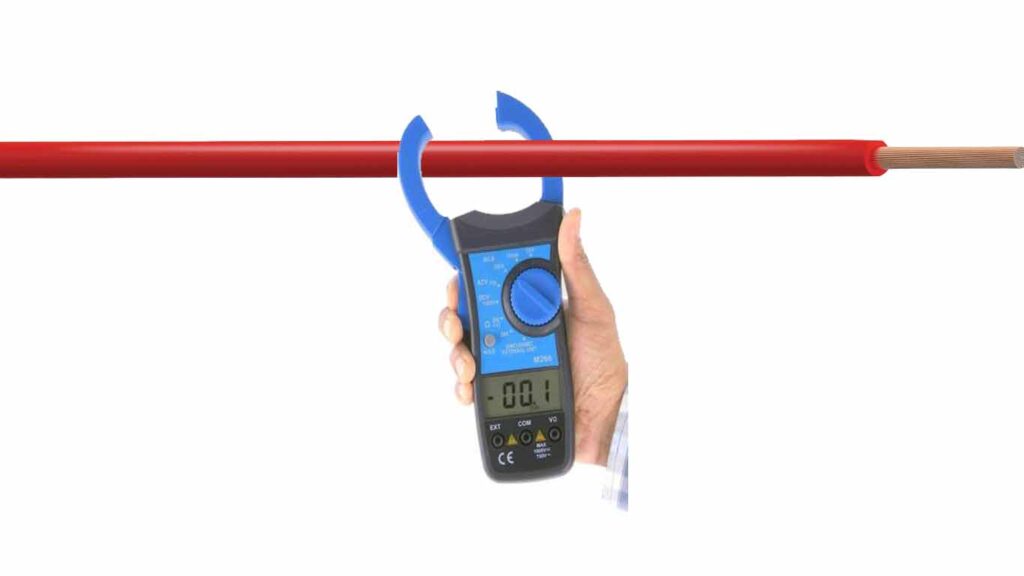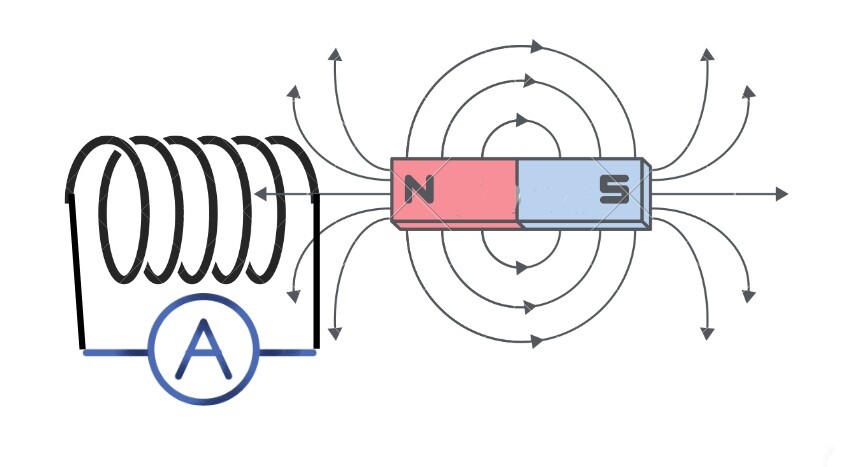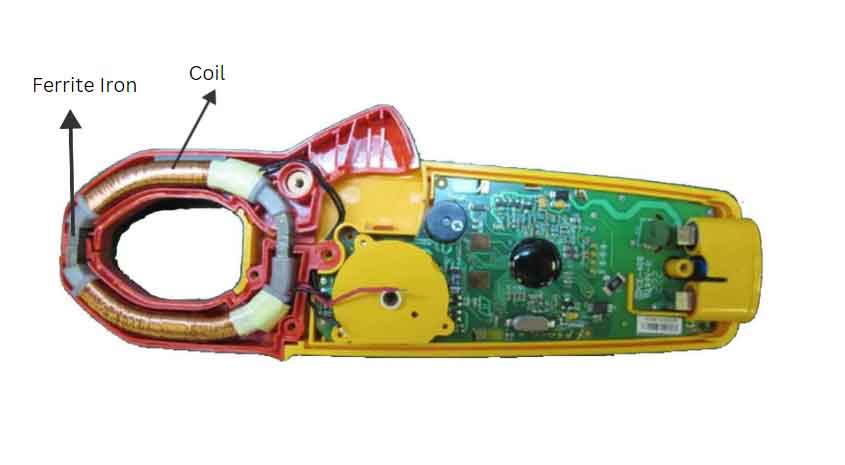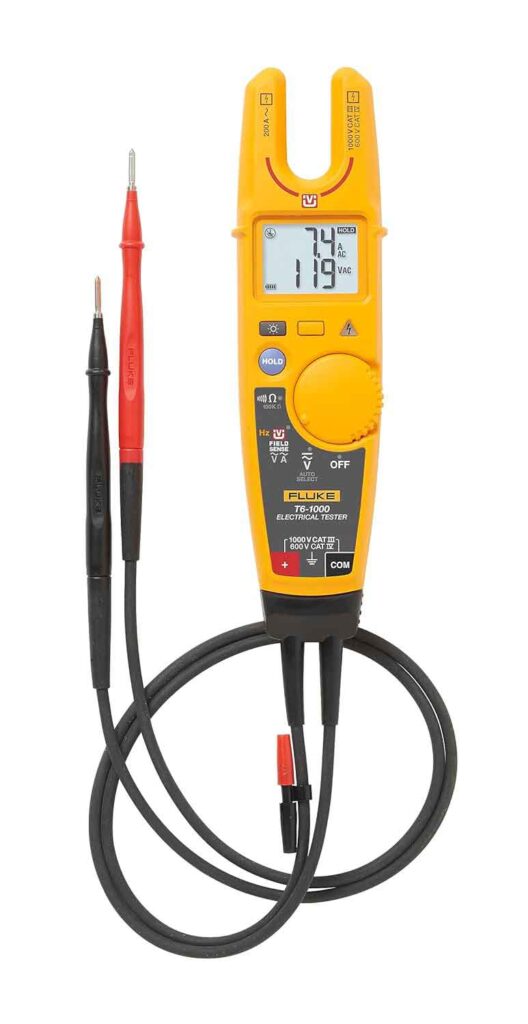A multimeter with a clamp/clip that measures only current; through a non-invasive method, is called a clamp meter. Clamp meters are a safe instrument to measure current in live circuits.
However, the importance of these clamp meters increased as additional and relevant functions were installed in them that were also found in multimeters. Hence, a clamp meter is a multimeter with a clip.
The clip/clamp of the clamp meter is made up of metallic sheets (to reduce Eddy current losses) insulated by plastic. This clamp is responsible for sensing current through electromagnetic induction in a passing-through wire. This method of sensing current added uniqueness to the clamp meters. It made the measurement of current safe, accurate, and easy.
We can say that a clamp meter is a familiar instrument if you glance at its function. However, the mode of operation is quite different from that of a multimeter.
Let us study more about the clamp meter and its unique feature: the clamp.
What is the Advantage of a Clip (Clamp) on a Meter?
The clip of a clamp meter helps us to detect the current in a wire. This method of measuring current is very productive and efficient. It increases efficiency at an astounding rate.
Extra care is given to the internal circuitry of the clamp meter that gets the signal from the clamp, as this signal needs proper conditioning.
Advantages of Clamp on a Meter
Through this clip, the function of the measurement took another pace in the field of Instrumentation and Measurement.
It not only increases accuracy but also makes its users safe while working in a live circuit or wiring.
Benefits of the Clamp
The meter with a clamp has advantages over other meters in two ways. First, it works as a mechanical support during reading. Second, it senses the current through a non-invasive method.
Let’s discuss these two points more elaborately.
1. Mechanical Support
During the reading, we can use this clamp to support our clamp meter. This made electricians comfortable in dangerous workplaces. However, for a perfect reading, the wire must pass through the clamp at the center.
Moreover, few models have wireless systems for taking readings (Bluetooth). In this case, the clamp meter is attached to the wire and the reading is taken remotely.
Thus, a user can safely and comfortably measure the current in a live circuit through a clamp.
2. Function
As we mentioned earlier, the basic use of clamp in clamp meters is to sense current. This is helpful and improves accuracy. This operation works in the following manner.
First, the clamp is placed around the wire. The wire must be carrying current (AC/DC). As we know, the current produces an electromagnetic field. The amount of electromagnetic field strength is proportional to the current.

It means the more current a wire carries, the more will be electromagnetic field strength.
Second, the electromagnetic field must be variable, not constant. To follow Faraday’s Law of electromagnetic induction, either the position of the wire or the value of the current will be variable.

In the case of AC, the value of current is variable. Hence, the electromagnetic field is also variable. For DC, things get out of hand. Here, Hall’s effect comes to the rescue.
Third, this changing electromagnetic field induces current in the clamp of the clamp meter. The metallic sheets are wound with wire, which works as a secondary coil (like a transformer).
The rate of change in magnetic flux (magnetic line cutting a surface) is related to the voltage produced in the clamp (Faraday’s Law).
Voltage=-N(Δꀺ∕Δt)
This voltage supplies current (induced current). This induced current is proportional to voltage, which is proportional to the rate of change in magnetic flux. These flux changes are due to AC in the wire.
As a result, the current induced in the clamp is related to the current in the wire. Hence, the clamp senses the proportional amount of current in the wire that is further passed through the conditioning circuit.
Inside the Clamp
The clamp of the clamp meter is made up of ferrite iron, commonly known as alpha iron. This iron resists hysteresis losses. Thus, the efficiency of the clamp meter increases.

Around the ferrite iron, the wire is wound for the detection of current. This wire works as a secondary coil for the clamp meter (current carrying wire being primary), just like transformers.
This coil is electrically connected to the remaining circuitry of the clamp meter.
All the sensing of current happens due to this simple structure. The remaining processes are dedicated to the signal processing circuit.
Alternative of Clip
Although clamp is the most common design for clamp meters, the same function can be performed through different approaches. Till now, we have witnessed two alternative designs for the clip.
1. Wire
The usage of wire as a clamp in a clamp meter is quite rare. However, some brands considered it as an alternative to hard clamp.

The wire is detached from one side of the main body of the clamp meter. After passing through the corresponding wire, the clamp wire is attached again. In this way, it takes reading.
There are some advantages of using wire as a clamp. Following are a few of them:
- Wire can access entangled areas for measuring current
- These models are easy to carry because of their small size
- We can replace it easily after a fault in the clamp wire
- Eddy’s current losses are minimized
However, it is not the favorite option of electricians, as they prefer the traditional clamp.
2. Parallel Rods
This is another alternative to traditional clamps for clamp meters. These rods work like clips in this clamp meter.

It must be noted that these instruments are generally known as Electric Testers. However, it measures current just like a clamp meter, following the same rule as discussed earlier.
We have Fluke T6-1000 (Amazon link) in this category (pictured above). As we said earlier, this is an electrical tester.
The two alternatives of the clamp are frequently witnessed in workplaces. The function of both is the same. The only change occurs in comfortability.
Conclusion
The clip or clamp of a clamp meter is the distinguishing feature of a clamp meter. Due to the clamp, the mode of measuring current not only improved but also became accurate.
Through a clamp meter, we can measure the current in a live circuit without disturbing the circuit physically. Users can safely measure a high amount of current through this method.
Clamp meters follow the principle of electromagnetic induction. To measure DC, Hall’s effect works. Both of these features are powered by the clamp/clip of the clamp meter.
Inside these clips, we have ferrite iron and winding copper wire around the iron. This assembly is responsible for detecting current. The induced current is further sent for processing.
We can replace these clips with a wire and parallel rods. The mechanism is the same for whatever the assembly is.
The clip or clamp attachment on meters represents a significant advancement in electrical measurement technology.
Other useful posts:
